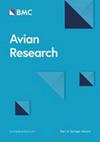测试城市边缘效应:在远离郊区公园边界的地区,巢捕食率更高
IF 1.7
2区 生物学
Q1 ORNITHOLOGY
引用次数: 0
摘要
城市绿地和公园为保持和增加鸟类的丰富度、多样性和物种丰富度提供了机会。然而,城市化影响了捕食者-猎物的相互作用,导致城市地区的高捕食率,特别是在英国,通过大量家猫的存在和共生物种(如老鼠和松鼠)数量的增加。这些高捕食率被认为是鸟类繁殖失败的一个重要原因。一些生态学家主张使用减少人类影响的缓冲区,以减少生态敏感地区潜在的狩猎压力。然而,对郊区筑巢鸟类捕食率的缓冲效应研究较少。在这项研究中,我们调查了边缘效应(巢址离房屋有多近)和巢高(即地面与地上)如何影响郊区公园的巢捕食率,使用相机陷阱监测含有鹌鹑蛋的人工巢。我们的假设是,缓冲区(距大学边界300 m)和较低高度的巢比核心区(距大学边界300 m)和较高高度的巢遭受更高的捕食率,因为缓冲区效应和容易接近地面捕食者会导致更高的捕食率。我们发现巢高对巢捕食率没有显著影响。然而,与我们的预期相反,核心区的巢比缓冲区的巢遭受更高的捕食率,并且鸦类负责几乎一半的卵丢失事件。我们推测,这可能是由于缓冲区附近的人为干扰(例如行人、遛狗、车辆)对鸟类巢穴捕食者起到了威慑作用。这项研究表明,保护城市遗址不受干扰可能并不总是能支持鸟类的丰富。本文章由计算机程序翻译,如有差异,请以英文原文为准。
Testing urban edge effects: Nest predation rates are higher in areas further from the boundary of a suburban park
Urban green spaces and parks offer opportunities for retaining and increasing bird richness, diversity, and species abundance. However, urbanisation influences predator–prey interactions, leading to high predation rates in urban areas, in the UK notably through the presence of large populations of domestic cats and increased populations of synanthropic species, such as rats and squirrels. These high predation rates are assumed to be a significant cause of reproductive failure in birds. Some ecologists advocate for the use of buffer zones with reduced human influence to reduce potential hunting pressure in eco-sensitive areas. However, the buffer effect on predation rates of nesting birds in suburban areas is rarely investigated. In this study, we investigated how edge effects (how close nest sites are to housing) and nest height (i.e., ground vs. above-ground) affected nest predation rates in a suburban park using camera traps to monitor artificial nests containing quail eggs. Our hypothesis was that nests in the buffer area (<300 m inward from university boundary) and at low height would suffer higher predation rates than nests in the core area (>300 m from the university boundary) and at height, as the buffer zone effect, and ease of access to ground predators would result in higher predation rates. We found no significant effect of nest height in nest predation rates. However, contrary to our expectations, nests in the core zone suffered higher predation rates than those in the buffer zone, and corvids were responsible for almost half of the egg loss events. We speculate that this may be a consequence of higher levels of anthropogenic disturbance (e.g., pedestrians, dog walking, vehicles) adjacent to our buffer zone acting as a deterrent to avian nest predators. This work suggests that protecting urban sites from disturbance may not always act to support bird abundance.
求助全文
通过发布文献求助,成功后即可免费获取论文全文。
去求助
来源期刊

Avian Research
ORNITHOLOGY-
CiteScore
2.90
自引率
16.70%
发文量
456
审稿时长
46 days
期刊介绍:
Avian Research is an open access, peer-reviewed journal publishing high quality research and review articles on all aspects of ornithology from all over the world. It aims to report the latest and most significant progress in ornithology and to encourage exchange of ideas among international ornithologists. As an open access journal, Avian Research provides a unique opportunity to publish high quality contents that will be internationally accessible to any reader at no cost.
 求助内容:
求助内容: 应助结果提醒方式:
应助结果提醒方式:


